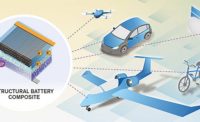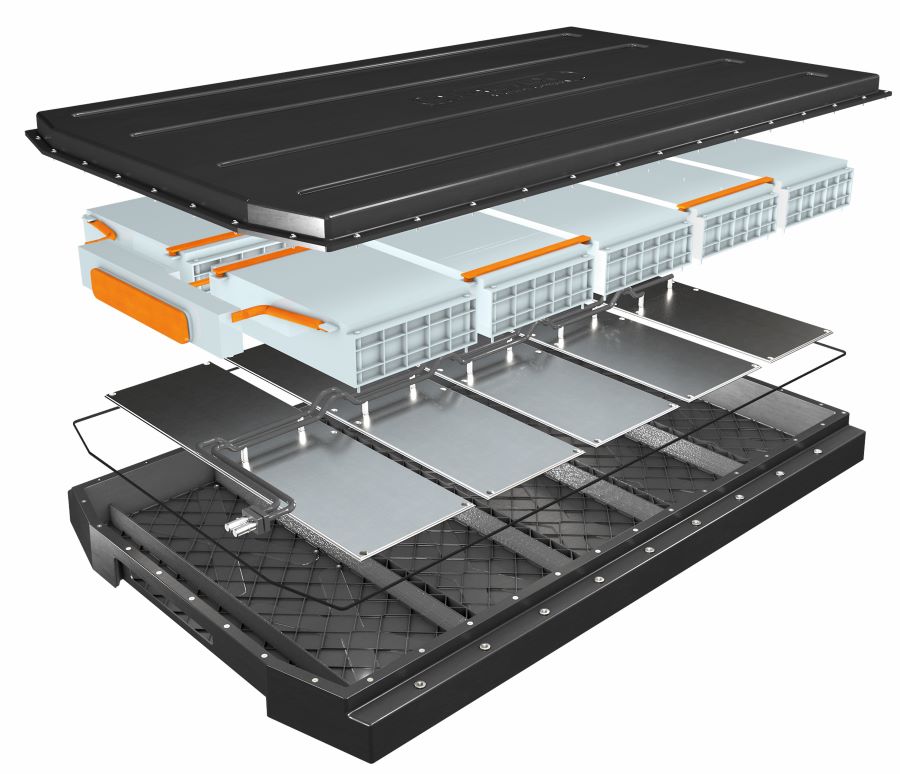Structural Batteries Could Reduce Electric Vehicle Weight

GOTHENBURG, Sweden—Engineers at Chalmers University of Technology have developed a structural battery that performs 10 times better than all previous versions. It contains carbon fiber that serves simultaneously as an electrode, conductor and load-bearing material. The breakthrough paves the way for “’massless” energy storage in electric vehicles.
Although engineers have been working on structural batteries for more than 10 years, it has been difficult to manufacture them with both good electrical and mechanical properties. The new battery has properties that far exceed anything yet seen in terms of electrical energy storage, stiffness and strength.
The battery has a negative electrode made of carbon fiber and a positive electrode made of a lithium iron phosphate-coated aluminum foil. They are separated by a fiberglass fabric in an electrolyte matrix.
“The carbon fiber acts as a host for the lithium and thus stores the energy,” says Leif Asp, a professor of material and computational mechanics who is heading up the R&D project. “Since the carbon fiber also conducts electrons, the need for copper and silver conductors is also avoided, reducing the weight even further.
“Both the carbon fiber and the aluminum foil contribute to the mechanical properties of the structural battery,” explains Asp. “The task of the electrolyte is to transport the lithium ions between the two electrodes of the battery, but also to transfer mechanical loads between carbon fibers and other parts.
“The batteries in today's electric cars constitute a large part of the vehicles' weight, without fulfilling any load-bearing function,” Asp points out. “A structural battery, on the other hand, is one that works as both a power source and as part of the structure, such as a car body.
“This is termed massless energy storage, because in essence the battery’s weight vanishes when it becomes part of the load-bearing structure,” says Asp. “Calculations show that this type of multifunctional battery could greatly reduce the weight of an electric vehicle.
“It is absolutely conceivable that [future] electric cars, electric planes and satellites will be powered by structural batteries,” claims Asp.
The battery has an energy density of 24 watt-hours per kilogram (Wh/kg), meaning approximately 20 percent capacity compared to comparable lithium-ion batteries currently available. But, since the weight of vehicles can be greatly reduced, less energy will be required to drive an electric car, and lower energy density also results in increased safety. And, with a stiffness of 25 gigapascals (GPa), Asp believes the structural battery can compete with many other commonly used construction materials.
A new project, financed by the Swedish National Space Agency, now underway aims to increase the performance of the structural battery even further. According to Asp, the aluminum foil will be replaced with carbon fiber as a load-bearing material in the positive electrode, providing both increased stiffness and energy density. In addition, the fiberglass separator will be replaced with an ultra-thin variant, which will provide faster charging cycles.
Asp estimates that such a battery could reach an energy density of 75 Wh/kg and a stiffness of 75 GPa. “This would make the battery about as strong as aluminum, but with a comparatively much lower weight,” he claims.
Looking for a reprint of this article?
From high-res PDFs to custom plaques, order your copy today!





